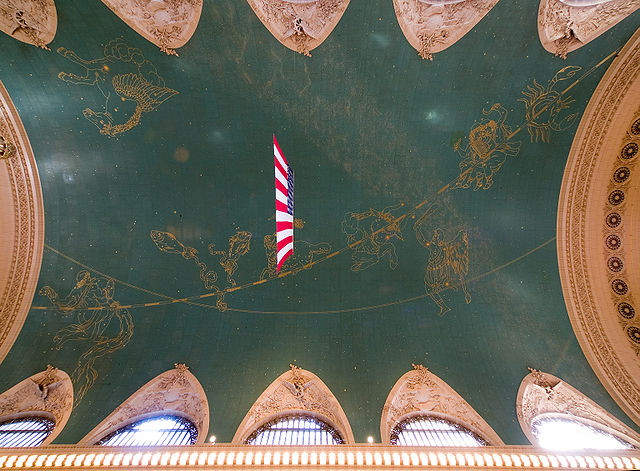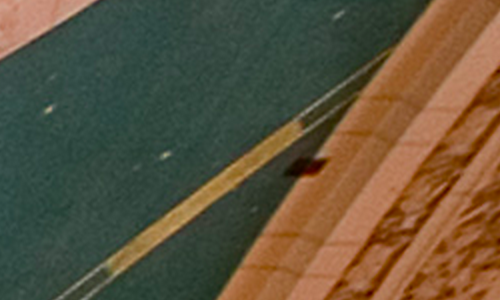The Faults in Their Stars
Grand Central Terminal is the historic train station in midtown Manhattan — hundreds of thousands of people commute into it each weekday. But typically, those people are focused on where they’re going, not where they are. But if they look up, here’s what they’ll see:

The picture is a bit outdated — as of this writing, there’s no American flag hanging there, but there were three balloons whose owners had (accidentally, one hopes) let go of them at an inopportune time. So let’s focus on the ceiling itself. The ceiling is an elaborate painted “skyscape” (to borrow Wikipedia’s term) intended to replicate the stars above the city on an October evening. But it has a few flaws. One flaw, in particular, was unintentionally created, but intentionally left behind.
In the upper-right of the image, you’ll see a crab, depicting the constellation Cancer. The crab’s left claw seems to be pointing at a dark spot located where the skyscape meets the molding of the building’s architecture. Can’t quite see it? Here’s a zoomed-in view of the spot, below. It’s the dark brown, rectangular area, half on the green and half on the beige:

That spot isn’t part of the ceiling’s original design.
Grand Central’s ceiling art was restored in the 1930s but, over the years, it grew dark and dirty — officials believed that the stains were the residue from the coal and diesel burned to power the trains. In the 1990s, the Terminal decided to clean the stains; as the Los Angeles Times would later report, “workers using cheesecloth dipped in soapy water took one year, and $1 million, to scrub the ceiling back to its original state.” But they left a small mark to remind future travelers of the damage done via years of train use.
The decision to keep the blemish was consistent with a previous decision from a few decades earlier. If you look carefully at the top image, you’ll see a black circle above the left-most fish in the constellation Pisces. (Here’s a close-up.) That, too, wasn’t part of the original ceiling. In 1957, NASA put a rocket on display in the atrium, but officials miscalculated the rocket’s height, requiring an ad hoc renovation — they poked a hole in the ceiling. While that hole could have been patched up afterward, officials decided to leave the hole as a reminder of the building’s history.
So it makes sense that the coal/diesel rectangle also be left behind — after all, this is a train terminal, and the mark speaks to the decades of trains that have serviced passengers. That spot is part of Grand Central’s long history.
Except — the spot isn’t from the trains.
During the cleanup process, inspectors analyzed the gunk that had collected on the skyscape above and found that it wasn’t made up of predominantly coal or diesel. Rather, the ceiling was stained by cigarette smoke — from the years and years of smokers walking through the building, puffing away. Today, the square serves as a reminder not only of the terminal’s history, but also of the dangers of smoking.
Bonus Fact: There’s one much more obvious problem with the Grand Central ceiling — if you know your star charts. As noted above, the images are intended to replicate an October night’s sky, but in this case, things didn’t go as intended. The image is backward. The official (but almost certainly fictional) explanation for this is that it’s a design decision, not an error, and the intent was to show the stars from outside the Solar System. But as astrophysicist Neil deGrasse Tyson told the New York Post, that doesn’t make any sense: “Alpha Centauri, the star system nearest to the sun, is 6,700 times farther from Earth than Pluto is. So just leaving the solar system will not fundamentally alter your view of the stars in our galaxy, and it certainly does not allow you to look at the constellations from behind.”
From the Archives: Titanic’s Star Wars: Another article that could have been titled “The Faults in Their Stars” — and one that also has a Neil deGrasse Tyson mention.
Related: “Grand Central: How a Train Station Transformed America” by Sam Roberts. 4.7 stars on 40 reviews.
